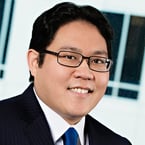3 minute read
Monday through Friday. 6:30 AM Pacific Time. A bell rings.
Domestic equity markets open and a new trading day for professional and retail investors begins. For those with exposure to global portfolios, their portfolio rarely sleeps as Asian equities begin their trading session overnight and then are followed by European markets. Regardless of location or asset class, each professional and retail investor begins their day with the same two risks: 1) the risk of losing money and 2) the risk of missed opportunities to make money. The first risk stares at us right in the face when it occurs, typically with a negative sign on our statement or perhaps highlighted in red text on our computer screen (or iPhone). The latter is a little harder to gauge. Did I pick the wrong asset class (i.e. cash vs. bonds vs. stocks)? Did the investment solution (mutual fund, separately managed account, or ETF) underperform their benchmark? Did I miss out on a single stock opportunity which has now shot to the moon?
Fear of missing out, also known as FOMO, is real. Our regret and angst is magnified even more due to the minute-to-minute daily dose of financial media which grades and highlights each decision real-time.
This is why it is important that investors must seek a balance between trying to make money and avoid losing money … at the same time.
Easier said than done, as each investor has their own unique tolerance and definition of success. For example, most investors look to the S&P 500 as the broad benchmark for large cap U.S. equities. Others look to the tech heavy NASDAQ Composite while some still look at the Dow Jones Industrial Average, a more value tilted index.
As of market close July 22, the year-to-date returns have been dramatically different.
Domestic Large Cap Indexes:
S&P 500: +1.40%
NASDAQ: +19.32%
DJIA: -5.37%
Prior to the Great Financial Crisis the penalty for sitting in cash was fairly low, as cash was yielding around 5%. Defensive assets have morphed greatly since the Great Financial Crisis due to interest rates being anchored at zero for most of the period following it. Cash once again yields close to zero. Here’s a look at how the 10-year U.S. treasury has changed over the last twenty years.
10-year U.S. Treasury yield:
January 2000: 6.68%
January 2010: 3.63%
January 2020: 1.51%
July 22, 2020: 0.60%
Today’s low interest rate environment equates to a higher risk/lower reward world. In order to seek higher returns, investors must be willing to accept one or more of the following: more volatility, more interest rate risk, more credit risk, less liquidity, or all of the above. High yield fixed income, the riskiest part of the bond market, currently yields about 5%, or about what cash used to yield. Playing defense has become much harder, but there are still defensive assets such as investment grade bonds, gold, and alternative strategies which are less correlated to broad equity markets.
Part of our job as your wealth advisor is to help you define your risk tolerance and distill it into a customized long-term investment strategy to better achieve your long-term goals, constantly thinking and adjusting playing offense and defense … at the same time.
Again, we are here and ready to do our best to answer any questions you may have or to just simply talk things through at times when you feel it may be helpful. We can navigate this together.



